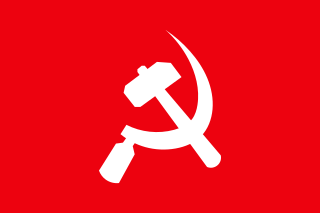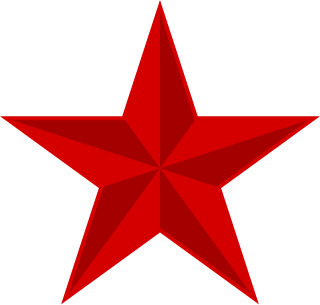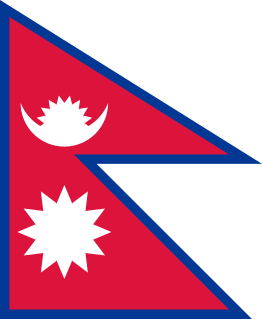
All Nepal Communist Revolutionary Coordination Committee (Marxist–Leninist) was a revolutionary communist movement formed in Nepal in 1975. ANCRCC(ML) had its roots in Jhapa District Committee of the Communist Party of Nepal as well as the Morang-based Nepal Revolutionary Organisation (Marxist-Leninist). In Jhapa armed struggle had been developed, inspired by the Naxalite movement in India.

Communist Party of Nepal (Marxist–Leninist–Maoist), was a minor communist party in Nepal. The party was as founded in 1981 by Krishna Das Shrestha. Initially it was known as the Nepal Marxist-Leninist Party. Shrestha had broken away from the Bagmati District Committee of the Communist Party of Nepal in 1969.
The Nepal Workers and Peasants Party(NWPP) or Nepal Majdoor Kisan Party is a political party in Nepal. The party was founded on 23 January 1975 by Narayan Man Bijukchhe. The party enjoys most of its support from Bhaktapur.

Communist Party of Nepal (Manmohan) was a communist party in Nepal, led by Man Mohan Adhikari.

Communist Party of Nepal (Burma), initially known simply as Communist Party of Nepal or Communist Party of Nepal , was a communist party in Nepal. The party emerged from a split in the original Communist Party of Nepal in 1962, representing the pro-Soviet sector of the party. Its main leader until 1983 was Keshar Jung Rayamajhi, who had been the general secretary of the original CPN.

Nepal Communist League was a communist organisation in Nepal. NCL was led by Shambhuram Shrestha. Shrestha, who had been a central secretariat member of the original Communist Party of Nepal, broke away from Man Mohan Adhikari's faction in the mid-1970s.
Nepal Revolutionary Organisation (Marxist–Leninist) was a communist organisation in Morang, Nepal. The group emerged around 1973, and was one of several local radical communist factions that surged in this period in Nepal. Madhav Kumar Nepal was the leader of the group.
Ruplal Bishvakarma was a Nepalese communist politician, peasant leader and Dalit activist. Ruplal hailed from a middle peasant family in the Chitwan district. Something of an oddity amongst Nepalese communist leaders.
Barre Sangarsh Samuha was a communist faction in Barre, Nepal. The group emerged in the early 1980s, after breaking off from the Communist Party of Nepal. It subsequently merged into the Communist Party of Nepal (Marxist-Leninist).
Nepal Workers and Peasants Organisation was a communist group in Nepal, led by Hareram Sharma. It was one of the two separate NWPOs that emerged from the original NWPO. The NWPO of Sharma held its party congress between October 22 and October 27, 1981
Nepal Workers and Peasants Organisation was a communist group in Nepal, led by D.P. Singh. It was formed when the Nepal Workers and Peasants Organisation of Hareram Sharma was divided into two.
Revolutionary Communist Organising Committee was a communist group in Nepal. The organ of the group was Rato Jhanda. The group was sometimes known as the Rato Jhanda group. The group had its origins in the faction led by Bharat Mohan Adhikari in the early 1970s, which was formed by a section of the Eastern Koshi Provincial Committee of the Communist Party of Nepal and a small splinter section of the Gandaki-based Marxist-Leninist Revolutionary Communist Party. However, this tendency had been deserted by Bharat Mohan, when he joined the Central Nucleus. Before constituting itself as the Revolutionary Communist Organising Committee, the group was called the Red Flag District Committee.
Revolutionary Communist Organisation, Nepal was a communist faction in Nepal. The group operated in the Bagmati, Janakpur and Koshi zones. The group publish Vargyuddha.
In 1980, an International Conference of Marxist–Leninist Parties and Organisations was organized by communist groups dissatisfied with the new leadership in China after the death of Mao Zedong and the overthrow of the Gang of Four. Participants were:

Mohan Chandra Adhikari is a former communist politician in Nepal. He hails from a Brahmin family in Morang District. Adhikari studied up to B.A. level, but didn't appear in the final exams. Adhikari had been a follower of Pushpa Lal Shrestha, but turned more radical than his mentor. Adhikari became a leader of the group in the Jhapa District Committee of the Communist Party which in the early 1970s intended to initiate a rebellion on the lines of the Naxalite insurgency in India.
Nara Bahadur Karmacharya is a Nepalese communist politician, belonging to Communist Party of Nepal. Karmacharya is one of the most senior political leaders of the communist movement in Nepal being the only surviving founding member of the Communist Party of Nepal, which had been born in 1949.

Narayan Man Bijukchhe is a Nepalese politician. Bijukchhe is the president of the Nepal Workers and Peasants Party.
Krishna Das Shrestha is a Nepalese politician who broke away from the Bagmati District Committee - which functioned semi-autonomously - of the Communist Party of Nepal in 1969 to found the Communist Party of Nepal (Marxist–Leninist–Maoist) in 1981. Shrestha was the party president.

The Revolutionary Internationalist Movement (RIM) was an international Communist organization founded in France in March 1984 by 17 various Maoist organisations around the world. It sought to "struggle for the formation of a Communist International of a new type, based on Marxism–Leninism–Maoism". The RIM appears to be defunct as are many of the founding organisations and many changed their names over the years, or have dropped active armed struggle.





